HAIR
ca: PÈL
es: PELO
Hair grows out from the skin of mammals and covers different parts of the body. Hair is made up of hundreds of very fine strands that grow together. They differ in texture, color and thickness with each animal.
Animal hair is used for the heads of brushes for painting, cleaning, etc. For working in ceramics, there are many different brushes made up with different hairs in varying sizes and shapes to leave different brush strokes and for work in special styles. In the ‘Brushes’ section there are photos of the different types with their names.
Synthetic hair is now commonly used in many paintbrushes and is more economical to buy. When you buy, make sure you know what you are buying. Read more about: Brushes – decorating
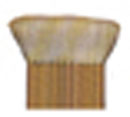 Hake brush is a soft, flat, wide Chinese brush useful for applying slips and glazes and also good for dusting work that is prepared but unfired.
Hake brush is a soft, flat, wide Chinese brush useful for applying slips and glazes and also good for dusting work that is prepared but unfired. 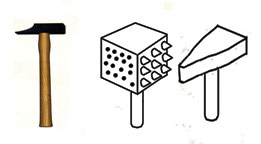 Hammer is a tool with a head attached crosswise on to the top of a handle and used for beating one object into another, like a nail into wood or a pole into earth. It is usually made of metal or wood.
Hammer is a tool with a head attached crosswise on to the top of a handle and used for beating one object into another, like a nail into wood or a pole into earth. It is usually made of metal or wood.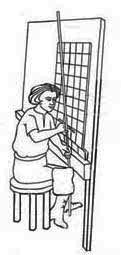
 A hand pole is a long, round, thin and strong bar that can be made of wood, plastic or metal. Mop handles are good, because some are extendable. In ceramics they are used for steadying your hand while painting in a sitting or standing position and must be long enough to paint the highest line of tiles you can reach while standing.
A hand pole is a long, round, thin and strong bar that can be made of wood, plastic or metal. Mop handles are good, because some are extendable. In ceramics they are used for steadying your hand while painting in a sitting or standing position and must be long enough to paint the highest line of tiles you can reach while standing.


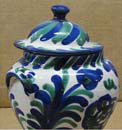 Lug handles: are small separate pieces of clay attached to casseroles and bowls with no or very little space between the lug and the wall, never enough for fingers to pass. There are two types and they are made with soft clay and applied to leather dry clay.
Lug handles: are small separate pieces of clay attached to casseroles and bowls with no or very little space between the lug and the wall, never enough for fingers to pass. There are two types and they are made with soft clay and applied to leather dry clay. 

 Harps are tools to trim and cut small slices in clay and are made of metal. They form three sides of a rectangle and have evenly placed notches at the bottom of each leg, in which a thin wire is held that connects the two sides and allows it to slice lumps of clay at different levels. The legs should be on the table, one on each side of the clay as it is pulled through, slicing in a straight line and separating the clay into two sections. For cutting large pieces. Read more about:
Harps are tools to trim and cut small slices in clay and are made of metal. They form three sides of a rectangle and have evenly placed notches at the bottom of each leg, in which a thin wire is held that connects the two sides and allows it to slice lumps of clay at different levels. The legs should be on the table, one on each side of the clay as it is pulled through, slicing in a straight line and separating the clay into two sections. For cutting large pieces. Read more about: 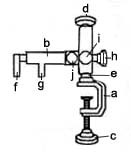 Hinge clamps; are designed to hold a screen over a flat product, such as tile, shirt, paper etc. to print on a design. It has two clamps: a) to attach it to a table or shelf with a knob c) to tighten it and b) at the end of the arm to hold the screen. At the top of the neck there is a screw d) that alters the height of the arm; space e) is the height. The frame of the screen is held between f) and g), the width between them can be altered by turning h) and i) which when tightened keeps it in place. The arm can be moved upwards 45º and the knob j) keeps it in place. This allows the screen to be tilted without altering its correct placing for printing. There are many types and sizes of hinge clamp, this is the simplest.
Hinge clamps; are designed to hold a screen over a flat product, such as tile, shirt, paper etc. to print on a design. It has two clamps: a) to attach it to a table or shelf with a knob c) to tighten it and b) at the end of the arm to hold the screen. At the top of the neck there is a screw d) that alters the height of the arm; space e) is the height. The frame of the screen is held between f) and g), the width between them can be altered by turning h) and i) which when tightened keeps it in place. The arm can be moved upwards 45º and the knob j) keeps it in place. This allows the screen to be tilted without altering its correct placing for printing. There are many types and sizes of hinge clamp, this is the simplest. 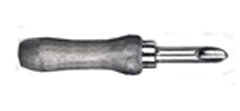 Hole cutter is a tool to pierce holes and dig out clay in general decorating. They are made in different sizes, with a handle and a stainless steel head which is a round empty tube, cut at the top at 45º.
Hole cutter is a tool to pierce holes and dig out clay in general decorating. They are made in different sizes, with a handle and a stainless steel head which is a round empty tube, cut at the top at 45º.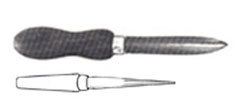 Hole piercer is a tool to pierce holes into clay, for lamps where the wire has to pass, for tea pots and for general decorating into clay.
Hole piercer is a tool to pierce holes into clay, for lamps where the wire has to pass, for tea pots and for general decorating into clay.  Hole cutters are tools to pierce holes and dig out clay in general decorating. They are made in different sizes, with a wooden handle and a stainless steel head which is a round empty tube, cut at the top at 45º.
Hole cutters are tools to pierce holes and dig out clay in general decorating. They are made in different sizes, with a wooden handle and a stainless steel head which is a round empty tube, cut at the top at 45º. 
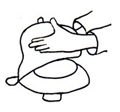 Hump mold is a mushroom shaped mold with a convex surface to make dishes.
Hump mold is a mushroom shaped mold with a convex surface to make dishes.  Hydrometer is an instrument used to measure the specific gravity (or relative density) of liquids; that is, the ratio of the density of the liquid to the density of water.
Hydrometer is an instrument used to measure the specific gravity (or relative density) of liquids; that is, the ratio of the density of the liquid to the density of water.